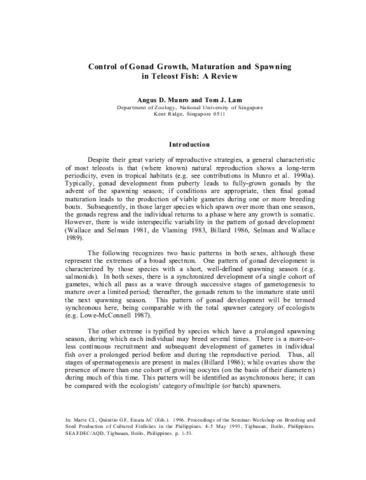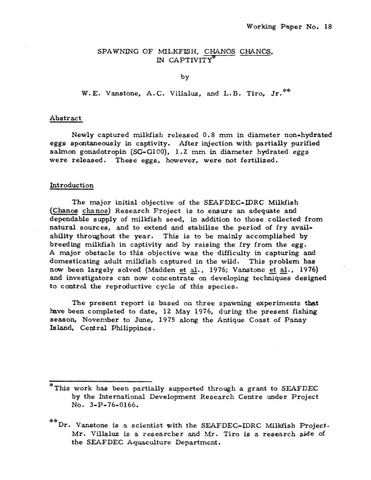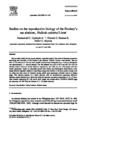Reproductive biology of mud crab Scylla tranquebarica found in Ratnagiri coast, Maharashtra, India
| dc.contributor.author | Naik, Suresh D. | |
| dc.contributor.author | Sonawane, S. S. | |
| dc.contributor.author | Pawar, A. S. | |
| dc.contributor.author | Hotekar, Shrikrishna Pandurang | |
| dc.contributor.editor | Quinitio, Emilia T. | |
| dc.contributor.editor | Estepa, Fe Dolores P. | |
| dc.contributor.editor | Thampi Sam Raj, Yohannan C. | |
| dc.contributor.editor | Mandal, Anup | |
| dc.date.accessioned | 2017-09-04T10:09:15Z | |
| dc.date.accessioned | 2017-09-04T10:41:03Z | |
| dc.date.accessioned | 2017-09-05T08:47:51Z | |
| dc.date.available | 2017-09-04T10:09:15Z | |
| dc.date.available | 2017-09-04T10:41:03Z | |
| dc.date.available | 2017-09-05T08:47:51Z | |
| dc.date.issued | 2015 | |
| dc.identifier.citation | Naik, S. D., Sonawane, S. S., Pawar, A. S., & Hotekar, S. P. (2015). Reproductive biology of mud crab Scylla tranquebarica found in Ratnagiri coast, Maharashtra, India. In E. T. Quinitio, F. D. Parado-Estepa, Y. C. Thampi Sam Raj, & A. Mandal (Eds.), Proceedings of the International Seminar-Workshop on Mud Crab Aquaculture and Fisheries Management, 10-12 April 2013, Tamil Nadu, India (pp. 69-77). Tamil Nadu, India: Rajiv Gandhi Centre for Aquaculture (MPEDA). | en |
| dc.identifier.isbn | 9788192989815 | |
| dc.identifier.uri | http://hdl.handle.net/10862/3211 | |
| dc.description.abstract | The study was carried out to determine the reproductive biology of the mud crab Scylla tranquebarica to provide baseline information that are useful in the seed production activities. Size at first maturation was observed in male crabs with 11 cm carapace width (CW) and in female crabs with 10 cm CW. The highest GSI values in male crabs (6.17) and females (5.12) were observed in October. The maximum number of eggs produced by females was up to 5 million. The egg diameter ranged from 0.69 to 0.76 mm at the heartbeat stage. Embryonic development was classified into five major stages: blastula, gastrula, nauplius pigmentation and heartbeat. The color of newly spawned eggs was orange. As the embryo developed, the color changed from orange to brown and finally to black prior to hatching. The incubation period was 11-13 days and the hatching success was 80%. The temperature and salinity during the incubation period ranged from 27 to 30°C and 30 to 35 ppt, respectively. | en |
| dc.language.iso | en | en |
| dc.publisher | Rajiv Gandhi Centre for Aquaculture (MPEDA) | en |
| dc.subject | Scylla tranquebarica | en |
| dc.subject | Reproductive biology | en |
| dc.subject | GSI value | en |
| dc.subject | India | en |
| dc.title | Reproductive biology of mud crab Scylla tranquebarica found in Ratnagiri coast, Maharashtra, India | en |
| dc.type | Conference paper | en |
| dc.citation.spage | 69 | |
| dc.citation.epage | 77 | |
| dc.citation.conferenceTitle | Proceedings of the International Seminar-Workshop on Mud Crab Aquaculture and Fisheries Management, 10-12 April 2013, Tamil Nadu, India | en |
| dc.subject.asfa | reproduction | en |
| dc.subject.asfa | gonadosomatic index | en |
| dc.subject.asfa | embryonic development | en |
Files in this item
| Files | ขนาด | รูป | View |
|---|---|---|---|
|
There are no files associated with this item. |
|||
รายการนี้ปรากฏใน (s)
-
International Seminar-Workshop on Mud Crab Aquaculture and Fisheries Management (ISMAF 2013) [15]
Proceedings of the International Seminar-Workshop on Mud Crab Aquaculture and Fisheries Management, 10 - 12 April 2013



